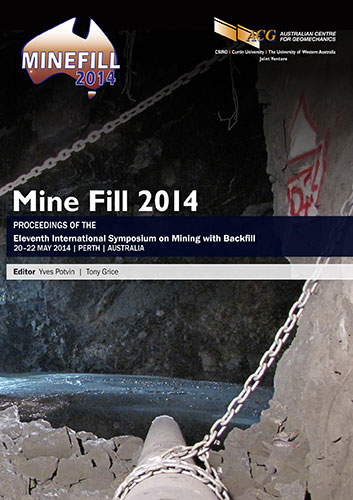Stream diversion and reinstatement on a mine backfill in tropical Borneo

|
Authors: Kemp, A; Russell, C; Keith, A |
DOI https://doi.org/10.36487/ACG_rep/1404_41_Keith
Cite As:
Kemp, A, Russell, C & Keith, A 2014, 'Stream diversion and reinstatement on a mine backfill in tropical Borneo', in Y Potvin & T Grice (eds), Mine Fill 2014: Proceedings of the Eleventh International Symposium on Mining with Backfill, Australian Centre for Geomechanics, Perth, pp. 503-516, https://doi.org/10.36487/ACG_rep/1404_41_Keith
Abstract:
The island of Borneo, of volcanic origin and lying astride the equator, presented the challenges of tropical wet seasons and volcanic soil to the relocation of a river to access coal seams, and subsequent reinstatement over the backfilled pit. Working together, the mining contractor and engineers developed a robust approach to accessing over 1 m t of coal that would otherwise have been sterilised by the river running over the seam. The process involved a staged approach including cutting off a river meander and training the river to maximise pit extent on the southern side of the river, relocation of the river through a large cutting to the north to mine under the original riverbed, backfill of the southern pit and reinstatement of the river similar to its original alignment on the mine backfill. The river diversion and reinstatement presented numerous significant technical and social challenges. The tropical location meant even the dry seasons often had significant volumes of rainfall for the river to drain to the Java Sea, hampering earthworks, while the wet seasons saw considerable water flows and flooding having to be handled by the river in its various configurations. Borneo’s geology is such that the local mine overburden material is not well suited to producing competent compacted earthworks. This meant regular importation of suitable material from Sulewesi at high cost for construction projects. Finally, the local indigenous community made use of the river as a water source and transport route, requiring attention to meeting their needs through all stages of the relocation and reinstatement. The adopted solution utilised the contractor’s expertise in getting the most out of the mine overburden and local material for earthworks construction combined with engineering hydraulic, geomorphology and geotechnical expertise. Working collaboratively, the combined expertise produced a low cost design to address the key risks of settlement, seepage, safety of adjacent open mine pit after reinstatement and changes to the river hydraulic gradient causing sediment regime changes and river scour. The final design, while maximising the use of uncontrolled backfill of the pit, used a limited thickness compacted mine overburden liner and an alignment and cross section that enabled the river to find its own alignment over time, but constrained it within limits to protect the adjacent pit. The provision of revegetation for the final alignment reinstated historic river amenity. Now, some four years after construction of the backfill and river reinstatement, the design has proved effective in achieving the aims of managing these risks and achieving a safe and robust outcome, sensitive to the post-mining environment and the local community.
References:
Charles, JA & Watts KS 1996, ‘The Assessment of the Collapse Potential of Fills and its Significance for Building on Fill’, Proceedings of the ICE - Geotechnical Engineering, vol. 119, no. 1, pp. 15-28.
Charles, JA & Watts, KS 2001 Building on fill: geotechnical aspects, Construction Research Communications, Watford, Hertfordshire.
Grady, J & Bethune, P 2003, ‘Permanent Creek Diversion Through Spoil – Back Creek, Queensland’, Proceedings of the Water in Mining Conference, Australasian Institute of Mining and Metallurgy, Carlton.
Hill CWW & Denby, B 1996, ‘The prediction of opencast backfill settlement’, Proceedings of the Institution of Civil Engineers, Geotechnical Engineering, vol. 119, issue 3, pp. 167-76.
Markham, A August 2004, Geomorphic Assessment of Jelamu River Diversions and Reinstatement, fieldwork progress report submitted to CW-DC Pty Ltd (now Aurecon), prepared by Hydrobiology, Brisbane.
Rutherfurd, ID, Jerie, K & Marsh N 2000, A Rehabilitation Manual for Australian Streams, vol. 1, Land and Water Resources Research and Development Corporation, Canberra, Australian Capital Territory, Cooperative Research Centre for Catchment Hydrology, Clayton, Victoria, viewed 24 February 2014,
pr000324.pdf.
US Army Corps of Engineers 2010, HEC-RAS River Analysis System, Hydraulic Reference Manual, Version 4.1, US Army Corps of Engineers, Davis.
© Copyright 2025, Australian Centre for Geomechanics (ACG), The University of Western Australia. All rights reserved.
View copyright/legal information
Please direct any queries or error reports to repository-acg@uwa.edu.au
View copyright/legal information
Please direct any queries or error reports to repository-acg@uwa.edu.au